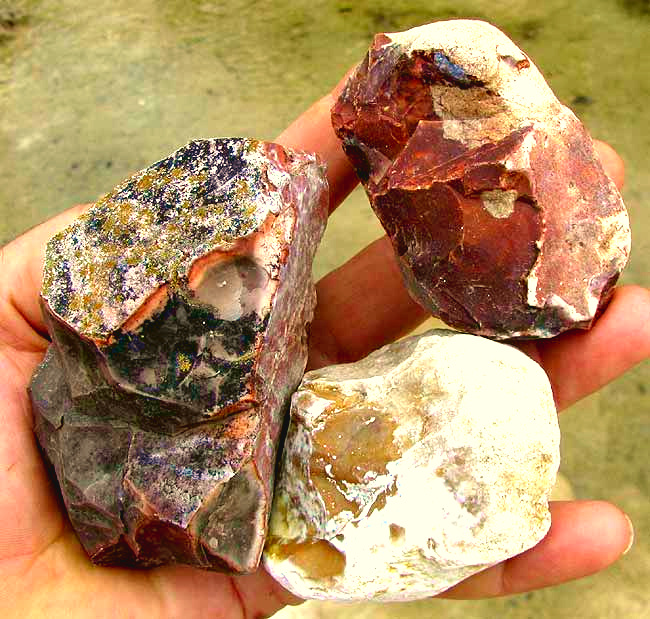Excerpts from Jim Conrad's
Naturalist Newsletter

from the October 28, 2012 Newsletter issued from the valley of the Dry Frio River in northern Uvalde County, southwestern Texas, on the southern border of the Edwards Plateau; elevation ~1750m (~5750 ft); N29.62°, W99.86°; USA
CHALCEDONY
On the cobblestone bars in the little Dry Frio River it's easy to find rocks like those shown above.
Because of their sharp corners it's tempting to call these flint rocks, flint being the stone from which America's indigenous folks knapped their projectile points. However, these rocks have too many "impurities" to be flint. Good flint -- rock that can be chipped into pieces possessing very sharp edges -- is glassier. Its broken surfaces shine with a waxy luster. They're "vitreous," a geologist would say. The broken faces of the rocks in my hand are too dull, and their sharp angles are not sharp enough, to be good flint.
If I had to designate what kind of rocks they are I'd call them chalcedony. Various pronunciations of "chalcedony" are accepted, but the preferred seems to be "Kal-SED-uh-nee."
The term chalcedony is a general one, a kind of catch-all term, which explains why the three rocks in the pictures can be of such different colors. Chalcedony is basically quartz, or silicon dioxide, containing small and varying amounts of other minerals, especially iron and aluminum. That accounts for the different colors. The redder rock in the picture would contain more iron, while the white one would have more aluminum. If the rocks were absolutely pure quartz, or silicon dioxide, they'd be crystalline, the crystals being hexagonal in shape, and transparent.
Some of chalcedony's various forms are bright and colorful enough to be regarded as semiprecious stones -- stones that can be polished and used for jewelry. If chalcedony is brightly red or brownish red and clear, it might be classified as carnelian or sard. If it's composed of layers of carnelian and sard, it's sardonyx or onyx. If it's bright green with red spots, it's heliotrope or bloodstone. If it's variegated or banded, it's agate. If it's agate with mosslike or treelike inclusions, it's chrysoprase. If it's variegated and mottled red, yellow and/or brown, it's jasper. And if it chips into very sharp edges and its faces display a waxy luster, it's flint.
While it's unusual to find chalcedony in these semiprecious forms, often you find chalcedony rocks clearly tending toward the semiprecious state. The reddish one in the picture, if it tried a little harder, well might qualify as carnelian or sard, but its luster is just too dull and there's little clearness to it. The blackish rock is tending toward flint, but it lacks a waxy luster and its chipped edges aren't sharp enough.
If the rocks were even duller in luster and showing even more rounded edges -- if there were more "impurities" in them -- instead of calling the rocks chalcedony we'd call them chert. Chert is quartz, or silicon dioxide, mixed with so many other minerals that it's sort of a "mongrel rock," generally pale orange-rusty and fracturing into very dull angles.
Chalcedony is to be expected in a geological environment such as a cobblestone bar in the Dry Frio River, for the Dry Frio issues from off the Edwards Plateau, which is mainly Cretaceous limestone. That limestone was once calcium-rich mud at the bottom of a warm, shallow sea. The mud also contained silica, iron, aluminum and other minerals.
It's the nature of mud on its way to becoming stone that through the agencies of time and pressure from above, atoms of mineral elements diffused throughout the mud migrate to join together, coagulate within the mud like oil droplets suspended in water. When the mud becomes rock, these "bubbles" of mineral concentrations form different rock than what surrounds them.
Atoms of silica in this environment combine with oxygen -- the third most common element in the Universe, after hydrogen and helium -- to form silicon dioxide. If the coagulations are pure silicon dioxide, quartz crystals form. If certain small amounts of other elements are present, chalcedony may form, and if there's a lot of other elements, chert may form.
It all makes sense, this landscape, and the things in it. It's all a great and wonderful music, if only you take the time to listen.